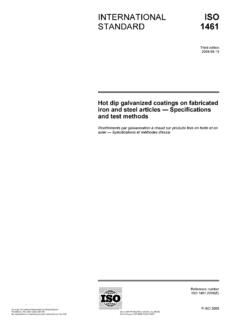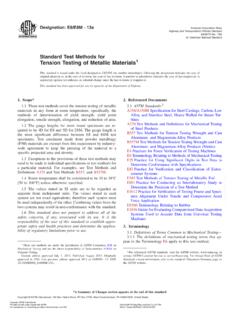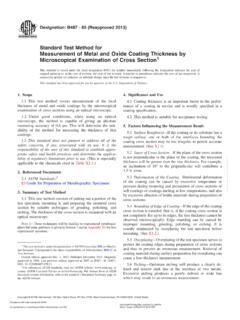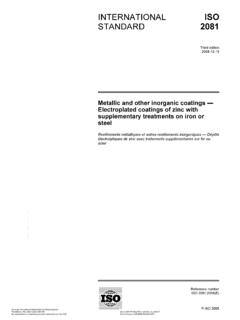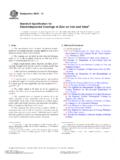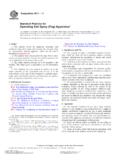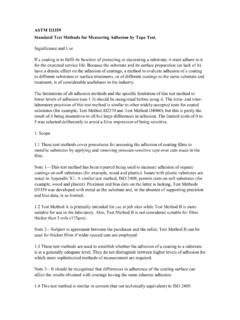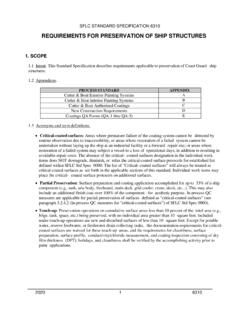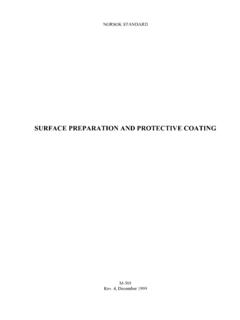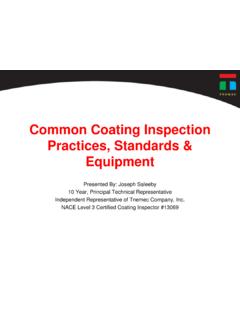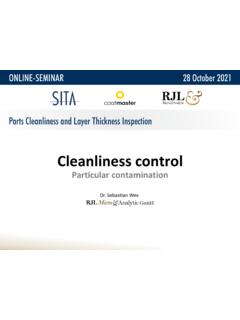Transcription of Standard Specification for Electrodeposited Coatings on ...
1 Designation: F1941 10 Standard Specification forElectrodeposited Coatings on Threaded Fasteners (UnifiedInch Screw Threads (UN/UNR))1 This Standard is issued under the fixed designation F1941; the number immediately following the designation indicates the year oforiginal adoption or, in the case of revision, the year of last revision. A number in parentheses indicates the year of last reapproval. Asuperscript epsilon ( ) indicates an editorial change since the last revision or specification covers the coating of steel unified inch screw threaded fasteners by electrodepo-sition. The properties of the Coatings shall conform to the ASTM standards for the individual thickness values are based on the tolerances for 1A and 2A external Unified Inch ScrewThreads. The coating must not cause the basic thread size to be transgressed by either the internal orexternal threads. The method of designating coated threads shall comply with normal methods for depositing metallic Coatings from aqueous solutions, there is a risk ofdelayed failure due to hydrogen embrittlement for case hardened fasteners and fasteners having ahardness 40 HRC or above.
2 Although this risk can be managed by selecting raw materials suitable forthe application of Electrodeposited Coatings and by using modern methods of surface treatment andpost heat-treatment (baking), the risk of hydrogen embrittlement cannot be completely , the application of a metallic coating by electrodeposition is not recommended for Scope* This specification covers application, performance anddimensional requirements for Electrodeposited Coatings onthreaded fasteners with unified inch screw threads. It specifiescoating thickness, supplementary hexavalent chromate or non-hexavalent passivate finishes, corrosion resistance, precautionsfor managing the risk of hydrogen embrittlement and hydrogenembrittlement relief for high-strength and surface-hardenedfasteners. It also highlights the differences between barrel andrack plating and makes recommendations as to the applicabilityof each The values stated in inch-pound units are to be regardedas Standard . No other units of measurement are included in The following precautionary statement pertains to thetest method portion only, Section9, of this specification:Thisstandard does not purport to address all of the safety concerns,if any, associated with its use.
3 It is the responsibility of the userof this Standard to establish appropriate safety and healthpractices and determine the applicability of regulatory limita-tions prior to Referenced standards :2B117 Practice for Operating Salt Spray (Fog) ApparatusB487 Test Method for Measurement of Metal and OxideCoating Thickness by Microscopical Examination of CrossSectionB499 Test Method for Measurement of coating Thick-nesses by the Magnetic Method: Nonmagnetic Coatings onMagnetic Basis MetalsB504 Test Method for Measurement of Thickness of Me-tallic Coatings by the Coulometric MethodB567 Test Method for Measurement of coating Thicknessby the Beta Backscatter MethodB568 Test Method for Measurement of coating Thicknessby X-Ray SpectrometryB659 Guide for Measuring Thickness of metallic and Inor-ganic CoatingsD6492 Practice for Detection of Hexavalent Chromium OnZinc and Zinc/Aluminum Alloy Coated SteelE376 Practice for Measuring coating Thickness byMagnetic-Field or Eddy-Current (Electromagnetic) Exami-nation Methods1 This specification is under the jurisdiction of ASTM CommitteeF16onFasteners and is the direct responsibility of Coatings edition approved Dec.
4 15, 2010. Published January 2011. Originallyapproved in 1998. Last previous edition approved in 2007 as F1941 07. referenced ASTM standards , visit the ASTM website, , orcontact ASTM Customer Service at ForAnnual Book of ASTMS tandardsvolume information, refer to the Standard s Document Summary page onthe ASTM *A Summary of Changes section appears at the end of this ASTM International, 100 Barr Harbor Drive, PO Box C700, West Conshohocken, PA 19428-2959, United ASTM International Provided by IHS under license with ASTM Sold to:NW PA Reg Plann and Dev Co, 759687 Not for Resale,05/15/2012 10:31:16 MDTNo reproduction or networking permitted without license from IHS--`,,````,,`````````,```,,`,,-`-`,,`, ,`,`,,`---F606 Test methods for Determining the Mechanical Prop-erties of Externally and Internally Threaded Fasteners,Washers, Direct Tension Indicators, and RivetsF1470 Practice for Fastener Sampling for Specified Me-chanical Properties and Performance InspectionF1624 Test Method for Measurement of Hydrogen Em-brittlement Threshold in Steel by the Incremental StepLoading TechniqueF1940 Test Method for Process Control Verification toPrevent Hydrogen Embrittlement in Plated or Inch Screw Threads (UN and UNR ThreadForm) Aerospace Standard (AIA):4 NASM-1312-5 Fast Test Method - Method 5: Stress Standard :5 IFI-142 Hydrogen Embrittlement Risk Management3.
5 Thickness the mean of the thickness measure-ments, of which a specified number is made within a local thickness the lowest local thicknessvalue on the significant surface of a single area the area within which a specifiednumber of single measurements are required to be surface significant surfaces are areaswhere the minimum thickness to be met shall be designated onthe applicable drawing or by the provision of a suitably markedsample. However, if not designated, significant surfaces shallbe defined as those normally visible, directly or by reflection,which are essential to the appearance or serviceability of thefastener when assembled in normal position, or which can bethe source of corrosion products that deface visible surfaces onthe assembled 1 and 2illustrate significantsurfaces on Standard externally threaded and internallythreaded Material The coating material shall be se-lected and designated in accordance withTable Thickness The coating thickness shall beselected and designated in accordance withTable 2 Finish When not specified, the hexavalent,trivalent or other chromiate finish shall be used at the option ofthe manufacturer and its appearance shall be selected inaccordance with the designation selected inTable for the purpose of this specification, aconversion coating shall not contain hexavalent Chromite Passivate Finish Unless other-wise specified.
6 The typical appearance of the trivalent chromitefinish shall be transparent, colorless and shall not be subjectedto the requirements of typical appearance as determined inTable 3. In addition, the classification code to be used shall beappended with the letter9T9(for example, Fe/Zn 5CT, asdefined inTable ). Passivate Finish Unless otherwisespecified, the typical appearance of the supplemental passivatefinish shall be transparent, colorless and shall not be subjectedto the requirements of typical appearances as determined inTable 3. In addition, the classification code to be used shall beappended with the letter S (for example Fe/Zn 5AS). Othercolored finishes may be specified at time of purchase. Require-ments of the other colored finishes to be agreed upon at time from American Society of Mechanical Engineers (ASME), ASMEI nternational Headquarters, Three Park Ave., New York, NY 10016-5990, from Standardization Documents Order Desk, DODSSP, Bldg. 4,Section D, 700 Robbins Ave.
7 , Philadelphia, PA from Industrial Fasteners Institute (IFI), 1717 East 9th Street, Suite1105, Cleveland, OH 44114 Black dot ( ) indicates test 1 Significant Surfaces on Externally Threaded FastenersNOTE1 Black dot ( ) indicates test 2 Significant Surfaces on Internally Threaded FastenersTABLE 1 Designation of Common coating MaterialsCoating DesignationCoating TypeFe/ZnZincFe/CdCadmiumFe/Zn-CoZinc Cobalt AlloyFe/Zn-NiZinc Nickel AlloyFe/Zn-FeZinc Iron AlloyTABLE 2 Designation of coating ThicknessNOTE1 The conversion factor from inch to microns is (forexample, in. = m).Thickness DesignationMinimum Thickness 102 Copyright ASTM International Provided by IHS under license with ASTM Sold to:NW PA Reg Plann and Dev Co, 759687 Not for Resale,05/15/2012 10:31:16 MDTNo reproduction or networking permitted without license from IHS--`,,````,,`````````,```,,`,,-`-`,,`, ,`,`,,`---NOTE1 The use of supplemental passivated finishes are technicallynot chromate films and they do not contain hexavalent chromium ions,they are supplemental Coatings that render the active zinc surface passiveand provide protection to the steel Ordering Information for When ordering threaded fasteners to be coated byelectrodeposition in accordance with this specification, thefollowing information shall be supplied to the The desired coating , coating thickness, the chromateor passivate finish, the color and appearance (if applicable), orthe classification codes as specified inTables 1-3.
8 (for example,Fe/Zn 5C denotes yellow zinc plated with a minimum thick-ness of in. on significant surfaces.) The identification of significant surfaces (optional). The requirement, if any, for stress relief before elec-troplating, in which case the stress-relief conditions must The requirements, if any, for hydrogen embrittlementrelief by heat treatment (baking) stating the tensile strength orsurface hardness of the fasteners and/or baking time Fasteners with a specified maximum hardness of 34 HRC andbelow have a very low susceptibility to hydrogen embrittlement and donot require The requirements, if any, for the type of electroplatingprocess (barrel-plating or rack-plating). See Section10andAppendix The designation of coated thread class shall complywith Requirements The Electrodeposited coating asordered shall cover all surfaces and shall meet the The coating metal deposit shall be bright or semi-bright unless otherwise specified by the purchaser, smooth, finegrained, adherent and uniform in The coating shall be free of blisters, pits, nodules,roughness, cracks, unplated areas, and other defects that willaffect the function of the The coating shall not be stained, discolored or exhibitany evidence of white or red corrosion Slight discoloration that results from baking, drying,or electrode contact during rack-plating, or all of these, as wellas slight staining that results from rinsing shall not be cause Resistance Coated fasteners, when testedby continuous exposure to neutral salt spray in accordance , shall show neither corrosion products of Coatings (whitecorrosion) nor basis metal corrosion products (red rust)
9 At theend of the test period. The appearance of corrosion productsvisible to the unaided eye at normal reading distance shall because for rejection, except when present at the edges of thetested fasteners. Refer toAnnex A1for neutral salt sprayperformance requirements for zinc, zinc alloy and The coating thickness shall comply withrequirements ofTable 2when measured in accordance on coating Thickness This specificationimposes minimum local thickness requirements at significantsurfaces in accordance withTable 2. Thick or thin localthickness in a location other than a significant surface shall notbe a cause for rejection. However the following Minimum coating thickness at low current densityareas, such as the center of a bolt or recesses, must be sufficientto provide for adequate chromate Threads Maximum coating thickness athigh current density threaded tips must provide for class 3 AGO thread gauge Threads Maximum coating thickness ofinternal threads must provide for class 1B, 2B, or 3B Go threadgage Surfaces such as threads, holes, deep recesses, basesof angles, and similar areas on which the specified thickness ofdeposit cannot readily be controlled, are exempted fromminimum thickness requirements unless they are speciallydesignated as not being exempted.
10 When such areas are subjectto minimum thickness requirements, the purchaser and themanufacturer shall recognize the necessity for either thickerdeposits on other areas or special to Unified Inch Screw The applicability of the required coating to unifiedinch screw threads is limited by the basic deviation of thethreads, and hence limited by the pitch diameter, allowance andtolerance positions. Refer toAppendix X3as a guideline forthe tolerances of the various thread sizes and classes and thecoating thickness they will Because of the inherent variability in coating thick-ness by the barrel-plating process, the application of a mini-mum coating thickness of in. is not recommended for astandard screw thread by this method due to the fact thatdimensional allowance of most threaded fasteners normallydoes not permit it. If the size of the fastener is large enough toeconomically use the rack-plating process, then the latter shallbe used to obtain this thickness requirement.

